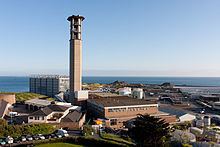Status In commission | Location St. Helier Commission date 1965 | |
 | ||
Primary fuel Oil Fired (HFO & Diesel) Operator Jersey Electricity Company | ||
La Collette Power Station is the main power station for Jersey, and is now the main control centre for the Channel Islands Electricity Grid. It is operated by Jersey Electricity. Under normal circumstances the power generation facilities served as an emergency supply in case of power interruption, however the failures of undersea cables in 2012 has changed La Collette's role to full-time generation.
Contents
The States of Jersey's waste-to-energy incinerator was built next to La Collette and shares its water supply and chimney.
HistoryEdit
The power station was constructed in 1965 to relieve Queens Road, which by then was struggling to keep up with demand. It was initially based on Mirrlees diesel engines and Parsons steam turbines. In 1991 two Sulzer 16ZA40S diesel engines were installed replacing the older Mirrlees engines. In 2012 the last Mirrlees 5 MW diesel engines were decommissioned and replaced by two newer and more efficient Sulzer engines with twice the power of the older engines.
In 1985 a 55 MW cable to France was constructed, and in 2000 another 90 MW cable was constructed. With the advent of the link to France parts of the plant were decommissioned. In 2012 both cables started experiencing problems with the 1985 cable becoming irreparable. The JEC had to start generating again to supplement the power supply from the cables.
In 2012, La Collette started generating more frequently, up to 24 hours per day 7 days per week if necessary, because of problems with the sub-marine link to Normandy which usually supplies power to the Channel Islands.
SpecificationEdit
Based on figures in a JEC leaflet the La Collette power station can produce around 200 MW. La Collette power station contains: (please note year is not date of manufacture but of arrival at La Collette)
Two of the four Sulzer engines were bought second hand from Saudi Arabia in early 2012, and were installed as part of a £9 million deal.
